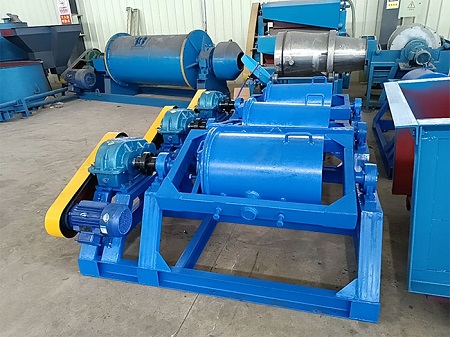The XMQ 400x600 cylindrical ball mill is a fully enclosed, dual-purpose (dry and wet) intermittent grinding equipment with a grinding capacity of 15-50 kg per batch. It is suitable for grinding fine materials in semi-industrial laboratories or other industrial applications, including building materials (especially cement, ceramics, and refractory industries), metallurgy, coal, chemical engineering, and more.
In ore beneficiation research, this cylindrical ball mill can not only function as a ball mill but can also be used as a rod mill by replacing the grinding media with steel rods, depending on the particle size requirements of the ground product for mineral processing methods. Due to its relatively large processing capacity, this cylindrical ball mill serves as an excellent transitional grinding device between continuous and intermittent grinding in ore beneficiation studies. It is also well-suited for mineral separation in artificial heavy sand preparation in geological laboratory work.

Operating Methods and Precautions for the Cylindrical Ball Mill
II. Structure and Working Principle
The cylindrical ball mill consists of a drum, frame, reducer, base, motor, and other main components.
The motor drives the reducer via a belt pulley, which then rotates the drum through a coupling and frame. Inside the sealed drum, steel balls (or rods) generate intense impact and grinding actions to crush the ore. The drum contains grinding media of various diameters (steel balls, rods, or pebbles). When the drum rotates around its horizontal axis at a certain speed, the media and raw materials are lifted to a certain height under centrifugal and frictional forces. When gravity exceeds centrifugal force, they detach from the inner wall of the drum and fall or roll down, crushing the ore through impact. Simultaneously, the sliding motion of the grinding media against each other further grinds the material.
III. Operating Procedures
Load an appropriate amount of steel balls into the drum.
Pour the material to be analyzed or tested into the drum. For wet grinding, add a suitable amount of water. Secure the end cover according to the grinding volume and start the grinding process.
Adjust the grinding time based on the hardness of the mineral.
After grinding, replace the sealed end cover with a sieve cover and discharge the material into a container.
Turn off the power after completing the work.
V. Installation and Maintenance Precautions
The machine requires a foundation for installation.
The machine must be properly grounded.
Before each operation, check whether the reducer, bearings, etc., have sufficient lubricant.
Lubricate the motor bearings according to the motor manufacturer's guidelines.
After completing the work, promptly clean residual waste ore or other debris from the drum liner.
VI. Safety Operating Procedures
1、Operators must receive safety training and strictly follow the product manual.
2、Do not approach moving parts while the machine is in operation.
3、Do not perform any adjustments, cleaning, or maintenance while the machine is running.
4、Do not manually adjust or move ore at the feed port or inside the grinding chamber during operation.
5、To prevent machine damage due to overload, use a starter compatible with the motor, equipped with an overcurrent protection device set to a safe current level.
6、Ensure the electrical system is well-grounded, and wires are enclosed in insulated conduits.







